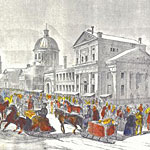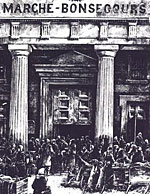

Electoral system
Major electoral changes occurred in 1852. Elections acquired greater importance since the mayor was now chosen by the electorate. City council meetings were held in a residence rented for such purpose. In 1852, city hall was located on the first floor of Bonsecours Market. The market occupied the ground floor of the building erected by the municipality.
The same year, the first electoral lists were drawn up by city appraisers, who were in charge of tax collection. Lists were posted at the city clerk’s office in the first weeks of January to enable electors to check if their names were correctly entered. Corrections or additions were reported to the city clerk’s office. All requests were submitted to the board of Revisors, made up of the mayor and four councillors appointed for such purpose.
A nomination procedure was also established and nomination meetings were organized in each district. Citizens submitted the names of candidates of their choice at 10 o’clock in the morning. In the event of a single nomination, that person was automatically elected. If there were several in the race, each candidacy was officially recorded. Seventy-seven citizens from the East district submitted their petition to Romuald Trudeau as follows:
A.R. Trudeau, Squire
Dear Sir:We the undersigned, electors of Quartier Est, respectfully request that you be designated as our representative in city council, at the next municipal election, and agree to cast our votes in your favor and to use our influence to ensure your election1.
The nomination meetings often developed into election campaigns. Candidates took advantage of the platform they were offered to make known their views. Mayoral nomination meetings seemed to attract the largest crowds. Newspapers reported that on such occasions, hundreds and sometimes thousands of people showed up at city hall to support the candidate of their choice. Candidates were often challenged by the crowds, and heated exchange of views were common. Those gatherings often ended up in brawls, even riots.
Elections were held “…between nine in the morning and four in the afternoon, from the fifteenth day of February to the Thursday between the first and second Monday in March of each year”2. Citizens could obtain their certificate from the city clerk’s office within that period. On that certificate, which was a sort of ballot paper, the elector had to enter the names of those running for mayor or councillor. He then had to deposit that ballot in the box corresponding to his district. The clerk then recorded the elector’s name and date of deposit of the certificate.
At the end of the election, the revising officers gathered for the count of the votes. Each ballot box was equipped with as many different locks as there were revising officers, so as to prevent corrupt practices. The announcement of results gave rise to spontaneous demonstrations. People marched in groups to cheer the successful candidates.
In spite of those new procedures, there were many irregularities in voting proceedings in the nineteenth century, and violent demonstrations were common. Citizens were not required to submit any proof of identity at voting time. Many often voted under a fictitious name, submitting certificates belonging to other electors. Groups gathered outside polling stations or around city hall in order to intimidate electors and even prevent them from voting. Election officials did not always show great zeal or authority when problems occurred.
Certain charter provisions bore on partisan demonstrations. It was forbidden by law to draw attention to one’s political affiliations by the use of flags, ribbons, cockades. In addition, any person in possession of “a cane, stick, bludgeon, club, axe handle…”3 could be arrested on the spot or detained during the voting period. But there were apparently not enough police officers on hand to prevent the outbreak of fights and riots.
1. Ville de Montréal. Division de la gestion de documents et des archives. Historical file 050, microfilm, spool 85, in La Minerve, February 17, 1852.
2. Provincial Statutes of Lower Canada 14-15 Victoria, Chapter 128, article XIX, August 30, 1851.
3. Ibid., article XXIII.

















